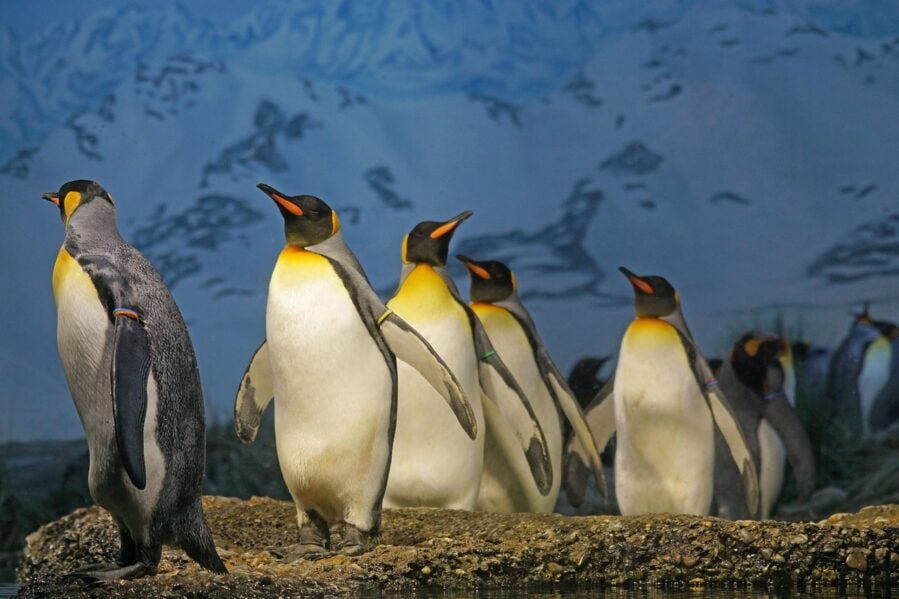Penguin colonies across Antarctica are literally changing the weather—and it’s all about their droppings.
New research reveals that ammonia from penguin guano creates massive hotspots of atmospheric particles that seed clouds and influence regional climate patterns. Scientists measuring air chemistry near a 30,000-pair Adelie penguin colony found ammonia concentrations rivaling those over agricultural fields, with the fertilized soil continuing to pump out climate-altering gases for months after the birds migrated away. This discovery connects Antarctic ecosystems to atmospheric processes in ways that could reshape our understanding of polar climate dynamics.
Ammonia Factories on Ice
The research team set up sophisticated atmospheric monitoring equipment near Marambio Station on the Antarctic Peninsula, directly downwind from major penguin breeding colonies. What they found surprised even seasoned atmospheric chemists.
Ammonia concentrations spiked to 13.5 parts per billion when winds blew from penguin colony directions—levels comparable to fertilized farmland. From other wind directions, including the Southern Ocean, ammonia was barely detectable.
But here’s where it gets interesting: the penguins left their breeding grounds halfway through the study, yet ammonia kept pouring off the landscape. The guano-enriched soil, which scientists call “ornithogenic soil,” continued releasing atmospheric chemicals for over a month after the last penguin departed.
The Cloud Connection
This isn’t just about smelly bird waste. The ammonia from penguin colonies combines with sulfuric acid from marine microorganisms to create new atmospheric particles through a process called nucleation. These tiny particles eventually grow into cloud condensation nuclei—the seeds around which water droplets form to create clouds.
During one remarkable day in February 2023, researchers watched this process unfold in real time. A strong particle formation event produced over 16,000 particles per cubic centimeter, which grew over six hours and directly contributed to fog formation.
Key Research Findings:
- Penguin-influenced air showed ammonia levels up to 13.5 ppb
- Particle formation occurred almost exclusively when winds came from penguin colonies
- Ocean sources contributed negligible ammonia compared to bird colonies
- Enhanced particle formation rates exceeded theoretical predictions by 1-4 orders of magnitude
- New particles successfully activated into cloud droplets during fog events
A Chemical Cocktail for Clouds
The story gets more complex when you examine the atmospheric chemistry in detail. While ammonia from penguins plays the starring role, it’s supported by a cast of other compounds that supercharge the cloud-seeding process.
Dimethylamine, also likely originating from penguin guano, acts as a powerful accelerant. This compound can boost particle formation rates by up to 10,000 times compared to ammonia alone, even when present at concentrations below one part per trillion.
The research reveals what scientists call a “multicomponent nucleation mechanism”—different chemicals working together to create atmospheric particles far more efficiently than any single compound could manage alone.
Climate Feedback Loops
This discovery has profound implications for understanding Antarctic climate systems, especially as the region faces rapid environmental change.
Penguin populations are already declining due to sea ice loss and habitat changes. Some species could face near extinction by century’s end. If fewer penguins means less atmospheric ammonia, that could reduce cloud formation and alter regional climate patterns—creating a feedback loop where climate change accelerates itself.
The researchers found that these coastal ammonia hotspots likely influence atmospheric conditions far beyond their immediate vicinity. While gaseous ammonia has a short atmospheric lifetime of hours to a day, the particles it helps create can persist for days and travel across the Southern Ocean and continental Antarctica.
Rethinking Remote Atmosphere
This research challenges assumptions about atmospheric processes in pristine environments. Scientists have long puzzled over why new particle formation rarely occurs in remote marine areas, despite the presence of sulfuric acid from marine organisms.
The answer may be ammonia availability. Without biological hotspots like penguin colonies providing ammonia, the chemical conditions needed for efficient particle formation simply don’t exist over most of the Southern Ocean.
The study also highlights how interconnected Antarctic ecosystems really are. Marine phytoplankton produce the sulfur compounds, penguins provide the ammonia, and their chemical marriage in the atmosphere influences cloud formation across vast areas.
A Changing Antarctic
Antarctica is experiencing some of the planet’s most rapid environmental changes. Sea ice extent has started declining within the past decade, ice shelves are shrinking, and these changes are already affecting Southern Ocean biology and penguin populations.
Understanding these ecosystem-atmosphere connections becomes crucial as conditions continue shifting. The research demonstrates that penguins aren’t just charismatic wildlife—they’re active participants in the climate system, helping to regulate atmospheric processes that influence regional and potentially global weather patterns.
As Antarctic ecosystems face mounting pressure, this study reveals yet another layer of complexity in predicting how polar regions will respond to continued warming. The clouds above Antarctica may depend more on the creatures below than anyone previously imagined.
If our reporting has informed or inspired you, please consider making a donation. Every contribution, no matter the size, empowers us to continue delivering accurate, engaging, and trustworthy science and medical news. Independent journalism requires time, effort, and resources—your support ensures we can keep uncovering the stories that matter most to you.
Join us in making knowledge accessible and impactful. Thank you for standing with us!

